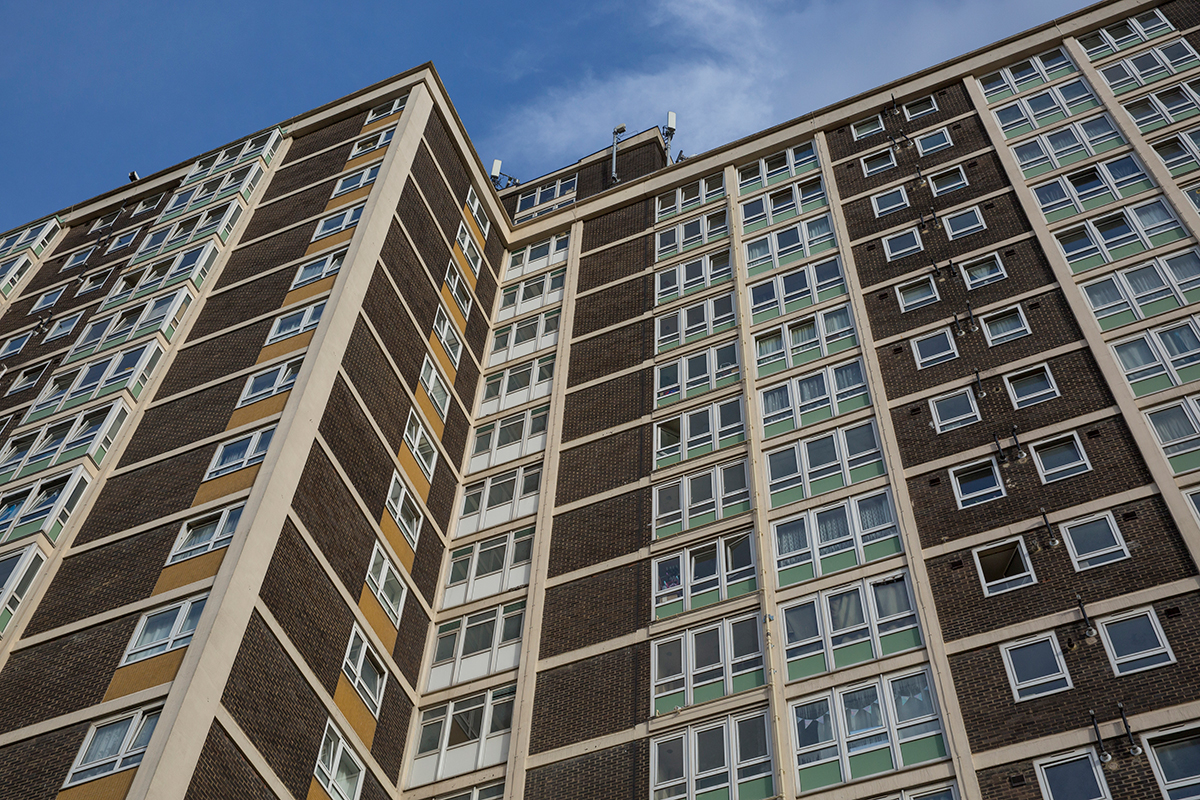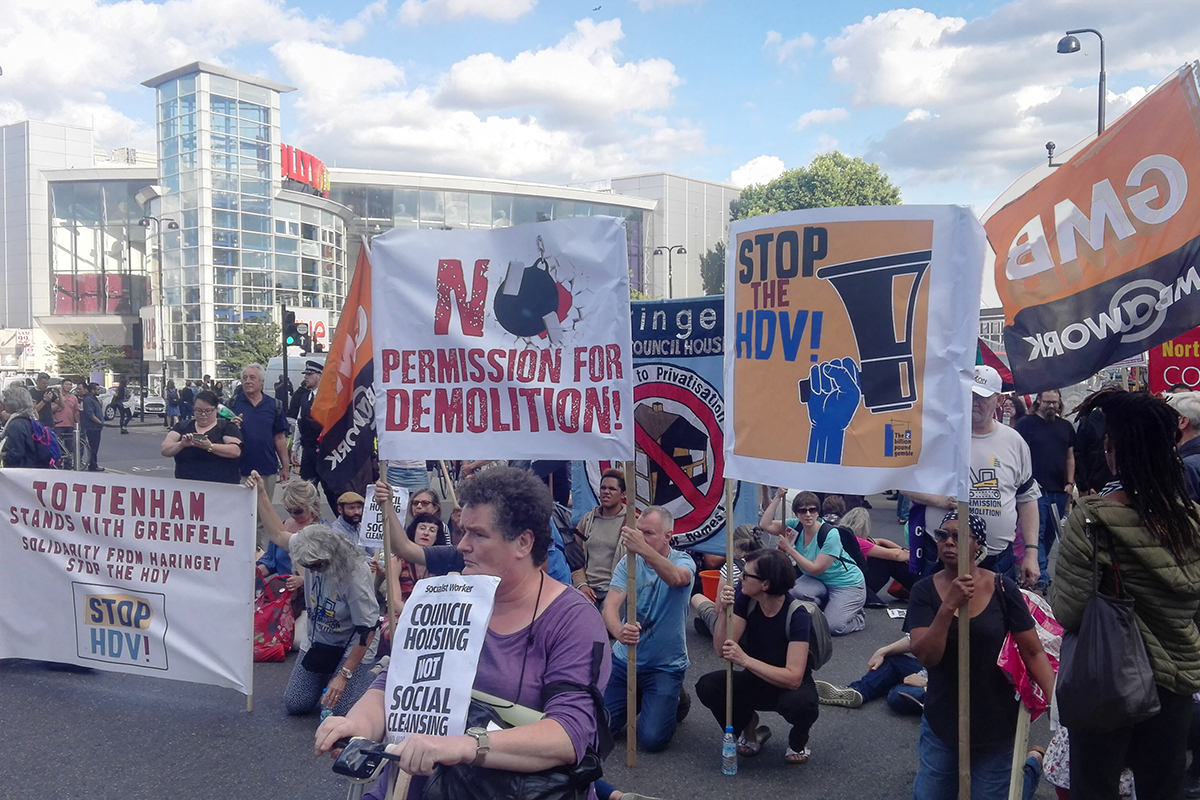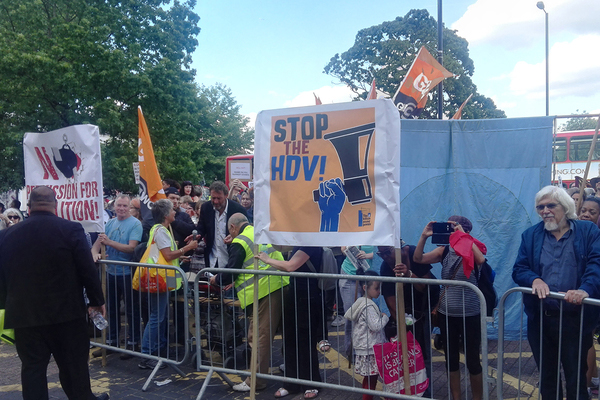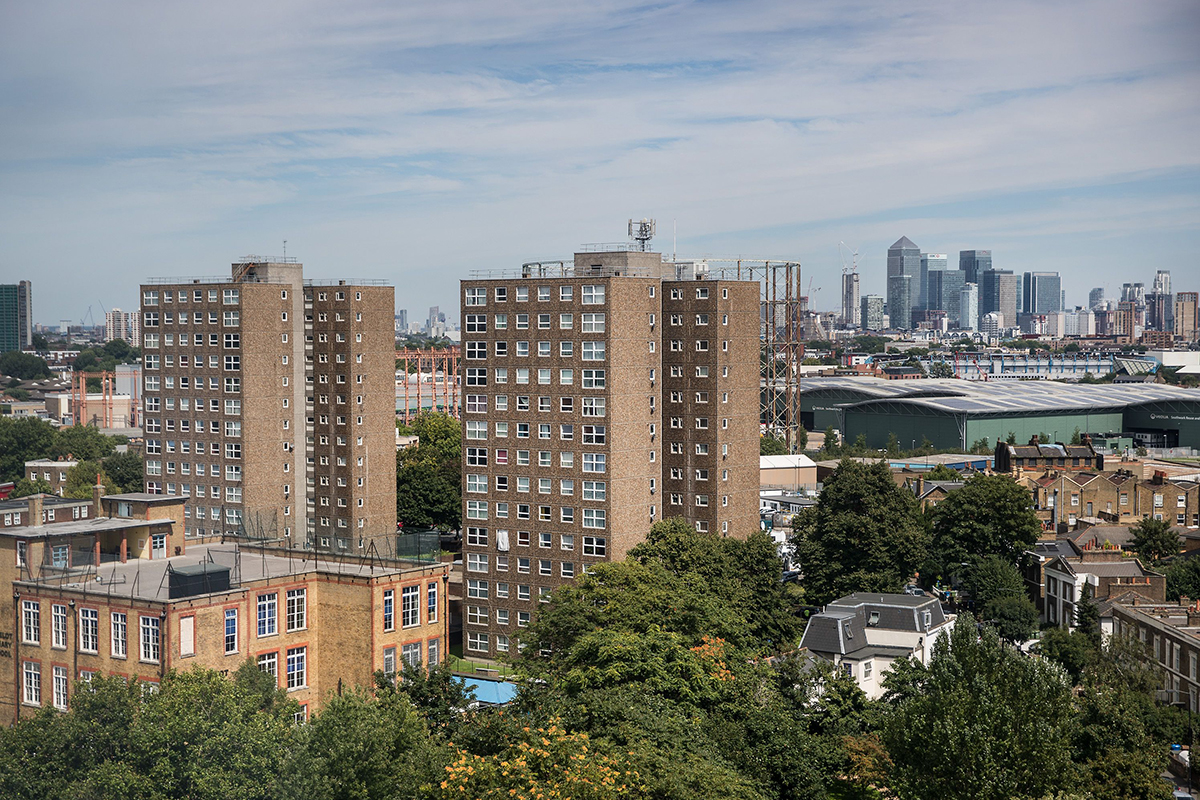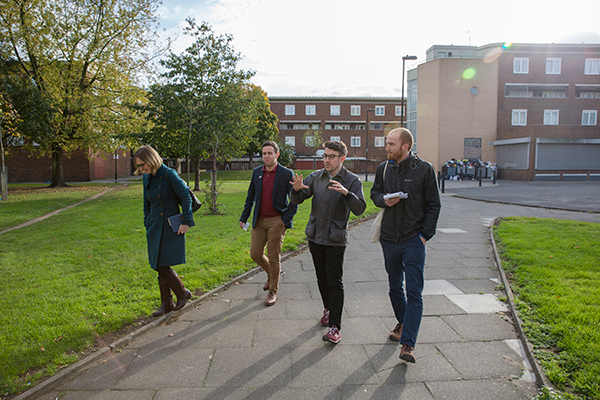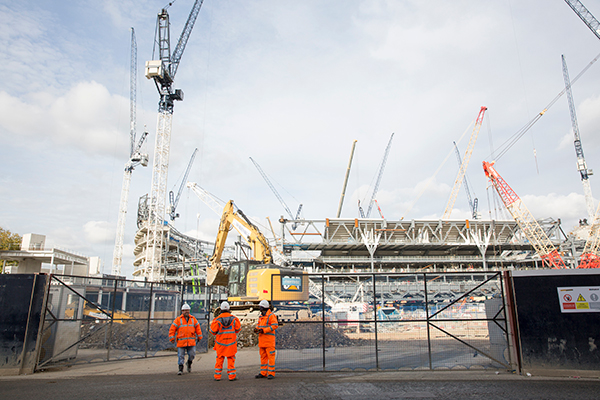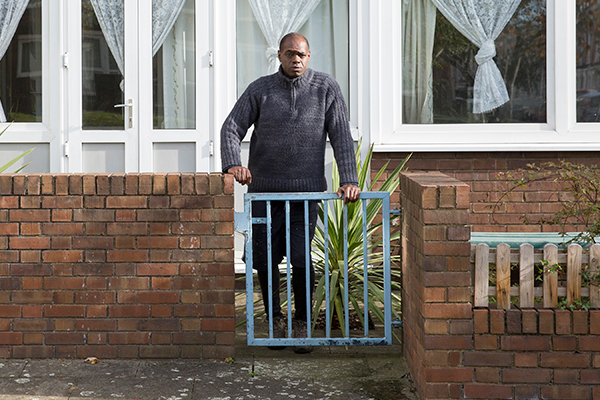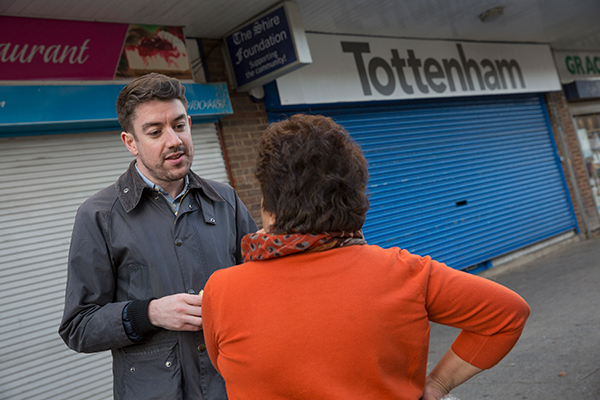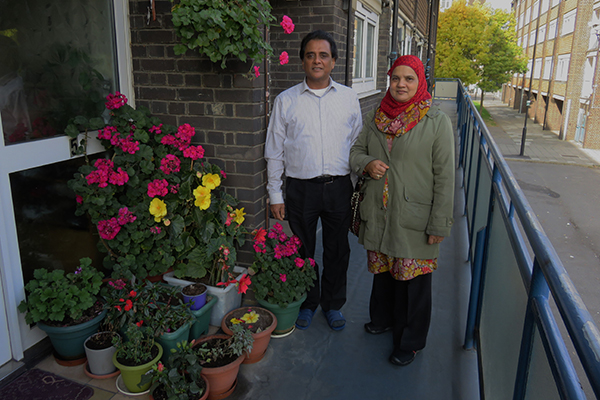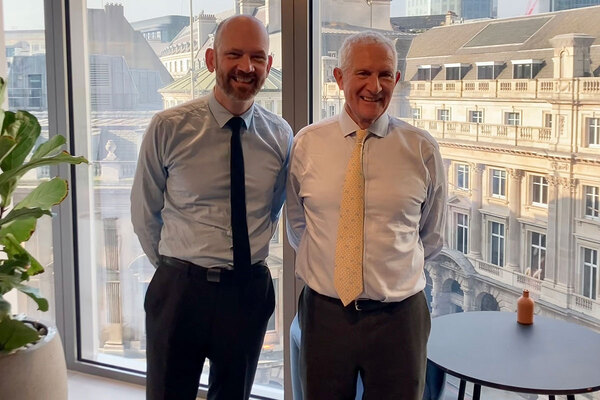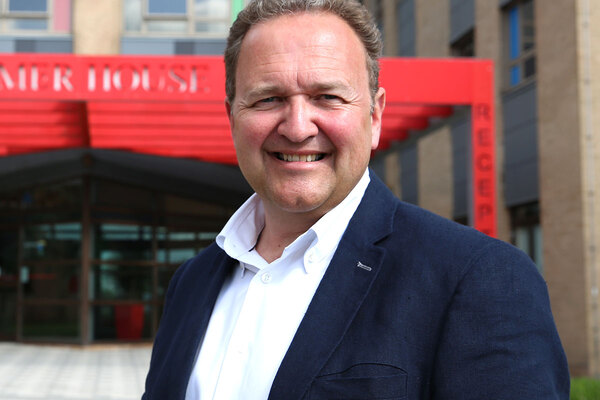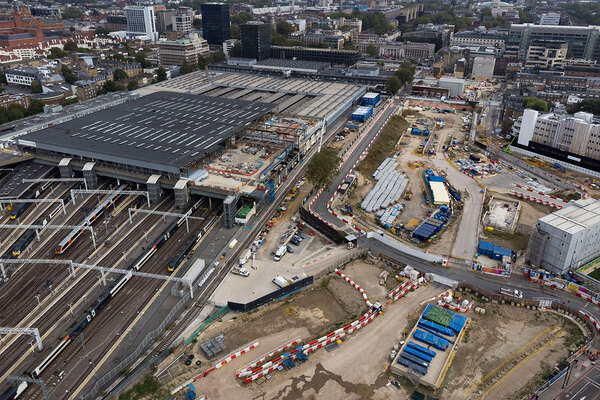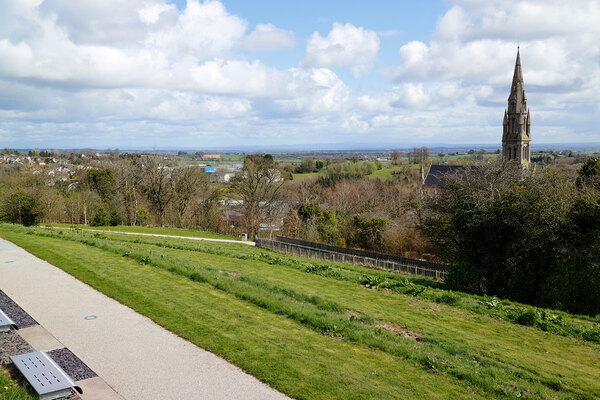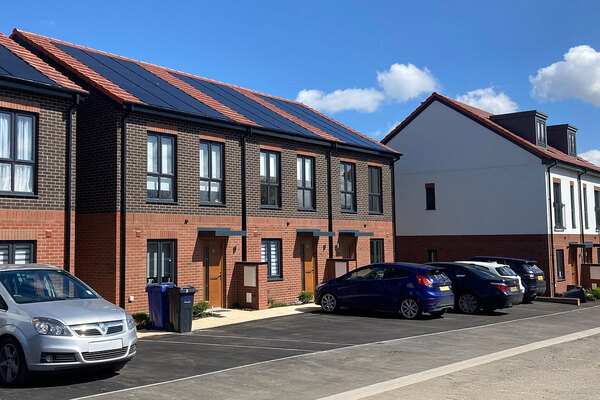You are viewing 1 of your 1 free articles
The battle for Haringey
Haringey Council has one of the most high-profile – and controversial – regeneration schemes in the UK. Tom Wall speaks to both sides. Photography by Sam Mellish
A pair of fresh-faced council officers clutching clipboards and bundles of glossy flyers pause briefly outside a block of council flats on the sprawling Northumberland Park Estate in north London.
They are here to tell Inside Housing about how they are keeping residents informed about Haringey Council’s ambitious and controversial regeneration plans for some of the most deprived parts of the country.
“We get generally quite positive responses. People want to hear what’s happening,” says one.
“The council is trying to maintain the community as it is, as much as possible,” chips in the other.
This is no chance encounter. Haringey Council’s press team has choreographed this meeting to counter what the council sees as myths propagated by the scheme’s opponents.
Alan Strickland, the council’s cabinet member for housing who has been watching the exchange, explains: “One of the things our critics have said is that ‘we are not talking to anybody’ and ‘we are not listening to tenants’. But here are two members of staff whose sole job is to do exactly that.”
The flyers for residents contain a map of the area and invites them to give their views on the estate. But it makes no mention of demolitions, land transfers or private developers.
Back in July, the council approved plans – which are currently subject to a judicial review – to transfer tens of millions of pounds’ worth of public land over the next 15 to 20 years to a private company, the Haringey Development Vehicle (HDV) (see box).
Sally Lowe (head of external communications), Josh Van Haaren (cabinet support officer) and Alan Strickland of Haringey Council, and Inside Housing’s Tom Wall
Haringey hopes the HDV – which is half owned by the council and half by a multinational private developer, Lendlease – will deliver affordable homes, community facilities and jobs.
However, the borough’s leadership is facing a battle. Both of the area’s Labour MPs, a vigorous grassroots campaign, and councillors sitting on the housing and regeneration scrutiny panel, which reviews the authority’s housing strategy, are lined up in opposition to the scheme.
They argue it’s an unnecessary gamble that could push out the poor; instead they want the council to stay in control by using a wholly owned company to release development cash, or borrow on a smaller scale over a longer period.
Indeed, Mr Strickland announced this week he would not be standing in the May local elections, after Labour Party members voted against his reselection. He will remain in post until then.
"Local MPs argue the HDV is an unnecessary gamble that could push out the poor"
All of the above could determine the future of regeneration and the relationship between hard-pressed councils in need of new homes and private developers keen to profit from prime land, which has
previously been off limits to them.
Back on the Northumberland Park Estate, Mr Strickland emphasises the “big decisions” have not been taken yet as consultations with residents are still underway.
Although the council has already approved proposals to demolish 889 council homes, 276 leasehold homes and 252 private homes on the estate, Mr Strickland says this could change as the final plans for the area take shape.
Building works and cranes for the new Tottenham Hotspur football ground, near the estate
“At this stage it is not really about giving people lots of information. It’s about sitting down with them, asking them, ‘What’s on your mind, what are you worried about’,” says Mr Strickland, who looks like a hipster in his New Balance trainers, wax jacket and chinos.
This kind of consultation is different to Jeremy Corbyn’s pledge at September’s Labour Party conference to introduce ballots for tenants and leaseholders in the future on estates threatened with demolition.
Mr Strickland says with a politician’s straight face that he “welcomes” the debate Mr Corbyn has started but insists that regeneration ballots are not the way forward. “Existing tenants’ views are really important, but what you can’t have is people saying, ‘I’m not interested in other people having affordable homes’,” he says. “The challenge for us as a council is to balance the needs and wishes of existing tenants with the needs and wishes of people who desperately need housing.”
"Mr Strickland insists regeneration ballots are not the way forward"
Mr Corbyn claimed deals with private developers had too often led to “forced gentrification and social cleansing”. The Labour leader may well have had in mind Southwark Council’s controversial deal with Haringey’s current partner, Lendlease, to redevelop the Heygate Estate in 2014, which resulted in 1,194 social rented homes being replaced with 198 homes at affordable rent, 316 shared ownership homes and 82 social rented homes.
How is Haringey going to avoid this outcome? “Other councils have not given a right to return and have not prioritised affordable housing,” says Mr Strickland carefully. “We are taking completely the opposite approach.”
The council’s right to return policy gives council and housing association tenants the right to move to an equivalent home on the estate with an equivalent rent and tenancy while the work is carried out, or to move back at a later date.
Resident Franklin Thomas
However, Mr Strickland accepts tenants will get a new landlord. “We can guarantee the terms but we can’t guarantee they’ll be council tenants,” he says. “The current plan is that the new company will own the homes.”
Leaseholders and homeowners will get a right to purchase a replacement home, although they may have to borrow extra from the council or settle for a shared ownership home.
Yet there are fears that if house prices rise rapidly some may not be able to afford to return. And the redevelopment will almost certainly leave private renters, who are not covered by the policy, struggling to come back.
“Neither in our policy or in law does someone renting privately have a right to return so it would be a question of our housing advice team sitting down with them and looking at their options,” he says.
"We can't guarantee they will be council tenants"
Throughout the tour of the estate, Mr Strickland is careful not to use the word “privatisation” – he prefers “partnership”. But isn’t the transfer of publicly owned assets to a private company, jointly owned by the council, at the very least part-privatisation? “Clearly there is significant private involvement in this – I’m not hiding from that,” he says slightly tetchily.
The council argues that this is the only way the authority could afford to redevelop such a deprived estate, where more than 30% of children grow up in poverty. “The cost of redoing this estate would be well north of a billion – we haven’t got that money,” Mr Strickland points out.
The HDV will deliver an estimated 5,000 new homes across the borough with 40% of them classed as affordable. This could include homes at social rents, affordable rents, which can be up to 80% of market rents, and shared ownership. It’s hard to know if the 9,000 people on the council’s waiting list for social housing or the 3,000 families in temporary housing will benefit from the scheme without a tenure breakdown. But Haringey cannot provide one as it says the details will be settled at a later date.
Alan Strickland chatting to a local resident in Northumberland Park
Nonetheless Mr Strickland is adamant that Tottenham needs change now. He says his opponents do not understand what it is like to live in an area blighted by crime and poverty. “Too many of the people criticising our plans do not live in Tottenham,” he says gesturing to an open grassy courtyard which he claims is frequented by drug dealers and moped gangs.
Later, as night falls over the estate, a group of residents opposed to the scheme gathers in the warm and spacious living room of Moriam Islam-Begum’s flat.
They are distributing a very different leaflet to the one handed out by council officers in the day. It reproduces a map from the council’s business plan for the estate, which proposes demolishing the equivalent of 71% of the homes in Northumberland Park.
The council insists these are initial proposals and that final decisions on block and street demolitions will only be taken after consultation.
Seven of the eight people in Ms Islam-Begum’s home are from the Northumberland Park regeneration zone, with four living on the estate itself. Ms Islam-Begum and her husband have lived on the estate for 30 years, first as council tenants and then as leaseholders. She has raised her three children here and entertained generations of kids in her front room.
“We are a close community. We trust each other,” she says from her sofa. “When there are children on the balcony, they come to our house. I bake them cakes and make popcorn.”
Moriam Islam-Begum with her husband
Ms Islam-Begum, who works in a local school, fears her family, some of whom are renting privately, could be driven out of the capital if the estate is demolished. “Whatever money they give me, I won’t be able to buy anything in London. We would have to be a cash buyer because we cannot get a mortgage,” she says. “When my house goes, my job goes – so I will be jobless and homeless at the same time. How can that be regeneration?”
Franklin Thomas, who has lived in the area since the 1970s, only found out about the plans from a local campaigner. “I go around the neighbourhood litter picking,” he says. “I got talking to another resident and then I looked at the council papers.”
Mr Thomas, a former lorry driver who cared for his mum before she died, says he would be devastated if he had to move out of his council flat. “This is what I know, this is what I came from,” he says.
He doesn’t trust the council’s promises and fears most residents will in reality not return once they’ve moved. “There should be a yes or no poll but Alan Strickland thinks we are too stupid to understand,” he says angrily.
Despite the council leadership’s best efforts, opposition appears to be growing in Haringey. Later that night Mr Thomas and Ms Islam-Begum, along with four others opposed to the scheme, are elected to the estate’s residents’ association. Labour Party wards have selected a raft of left-wing candidates to contest local elections in May, which could tip the balance of power in the council chamber against the HDV.
All of which leaves significant question marks hovering over the HDV. It’s perhaps no surprise Mr Strickland says: “I’m not sure politicians are ever confident about the future.”
A short history of the situation
November 2015
Haringey Council’s cabinet decides the only way to alleviate the borough’s stark housing crisis is to bring in a private developer.
July 2017
Local MPs David Lammy and Catherine West press the council to abandon the plan in favour of a wholly owned development company. Haringey Town Hall is surrounded by hundreds of protestors banging pots and pans but the cabinet agrees to establish the HDV with Lendlease.
October 2017
The High Court hears suggestions that the cabinet has failed to consult residents properly or allow the full council to vote on the scheme. The ruling is expected next month (December).
November 2017
Council leader Claire Kober survives a reselection battle to contest the May local elections, but a raft of anti-HDV Labour candidates are selected over sitting councillors.
UPDATE: at 10.25am 24.11.17
An earlier version of this article incorrectly said Haringey Council was transferring public land worth £2bn into the HDV. This is incorrect, the value of the land being transferred is "tens of millions of pounds", the council said.
The £2bn refers to the Gross Development Value - a measure taking into account capital and rental value of property - of the regeneration scheme once works have been completed.
